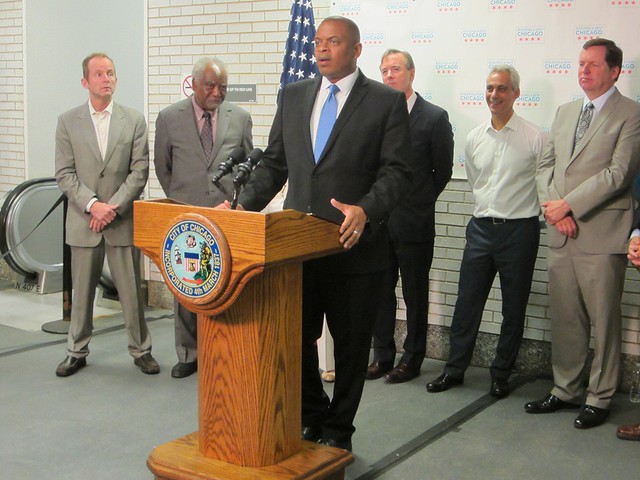
U.S. transportation secretary Anthony Foxx stopped by the CTA’s Granville station this afternoon to announce Chicago as the first city to be awarded a $35 million federal “Core Capacity” grant to modernize the Red and Purple lines. He also put a word in for President Obama’s proposal for a long-term transportation funding bill, the “Grow America” act.
The Core Capacity program was launched in 2012 to provide money for repairing infrastructure and expanding capacity on existing, aging transit systems. The U.S. DOT and the city of Chicago are touting the $35 million grant as a “down payment” on the $1.7 billion Red and Purple Modernization, one of the largest capital projects in CTA history. Upon completion of federal requirements, the transit authority expects to win an additional $600-700 million in additional federal funds for RPM.
The initial grant will cover preliminary design, engineering, and environmental planning for the first phase of the rail project. This stage will include rebuilding the Lawrence, Argyle, Berwyn, and Bryn Mawr stops to make them wheelchair accessible, as well as replacing track and signaling systems, and widening platforms. Phase I also includes a controversial Belmont flyover, which would allow for increased capacity and eliminate a service bottleneck, but would also require demolishing some 16 buildings.
CTA President Forest Claypool kicked off the press event in the small ‘L’ station by underscoring the importance of the Red Line, which he called the backbone of the CTA rail system. He noted that the line serves 40 percent of all CTA riders -- more than 250,000 people per day. Ridership on the Red and Purple lines grew by 40 percent between 2008 and 2013, and Claypool said ridership is expected to grow at a similar pace over the next five years.
“If we do nothing, trains will become more crowded, service will become much slower, reliability will be diminished, and we will literally leave people behind,” Claypool added. He applauded Mayor Emanuel’s efforts to address the challenge with projects like last year’s South Red Line rehab, the reconstruction of the 95th Street and Wilson stations – both slated to break ground this year at a total price tag of nearly $450 million – and now the RPM project.
Foxx said that, as the former mayor of Charlotte, North Carolina, he understands the challenges of finding funding for transportation projects. He complimented Emanuel and other local politicians on their tenacity in lobbying his department for the transit money. “When I see 312 coming through on my phone, I’ve learned to just automatically say, ‘Hi Rahm.’” he joked.
The transportation secretary mentioned a recent Chicago Magazine piece on the future of local transportation, in which Chrissy Mancini Nichols, a director at the Metropolitan Planning Council, expressed a modest wish: “If you’re riding the Brown Line, it doesn’t just sit and lurch.” “I think that’s a fair request,” Foxx said. “Investing in transit is the most effective way to move people around big cities, just like Chicago.”
Foxx noted that, across the country, over $86 billion in transit maintenance is needed. “100 million more people will have to move around by 2050," he said, referring to the nation's growing population. "Many of them will be concentrated in metro areas. That’s why I’ve been urging Congress to pass a long-term transportation bill that will support the future needs of Chicago and the entire U.S.”
He said the Grow America act would boost transit funding by 70 percent. The bill would increase Illinois’ rail transit maintenance funding by $300 million and bus maintenance by $40 million in the first year alone. “That would mean, maybe we could transform 'sit and lurch' into 'sit and go home for dinner.'” Foxx asked Chicagoans to tweet photos of potholes and other infrastructure challenges with the hashtag #InvestNow to let Congress know that more transportation dollars are needed to solve these problems.
Emanuel thanked Foxx effusively for the $35 million, and expressed confidence that Chicago will win funding to complete the RPM project. He added that, along with the recently completed South Side upgrades, the North Side improvements will mean that all Red Line riders “will experience the ability to go at 55 mph, rather than at 15.”
Emanuel had a close relationship with previous transportation secretary Ray LaHood, and it appears he’s also on good terms with Foxx. The Chicago mayor said he was already friendly with Foxx when he was a fellow mayor. “He understands what an investment in public transportation means for economic growth,” Emanuel said. “Having somebody [as transportation secretary], that you don’t have to kind of explain what transit means to a neighborhood, is so important.”




